Transatlantic Trophy
The Transatlantic Trophy (initially called Anglo-American Match Races) was an annual series of motorcycle races between the United Kingdom and America held from 1971 to 1988 and again in 1991. They were mostly held over the Easter weekend at Brands Hatch, Mallory Park and Oulton Park, although some races were held at Donington Park and Snetterton. Three different specifications of motorcycles were used in the series at various times: AMA/F750, Superbike and GP.[6]
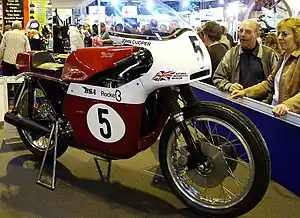 British rider John Cooper's 1971 BSA | |
| Category | Motorcycle road races |
|---|---|
| Country | UK |
| Inaugural season | 1971 |
| Folded | 1991 |
| Anglo-American Match Races | |||
|---|---|---|---|
| Year | Team | Results | Team |
| 1971 | UK | 183-137[1] | USA |
| Transatlantic Trophy | |||
| Year | Team | Results | Team |
| 1972 | UK | 252-210[1] | USA |
| 1973 | UK | 416-398[1] | USA |
| 1974 | UK | 416-401[1] | USA |
| 1975 | UK | 242-279[1] | USA |
| 1976 | UK | 412-384[1] | USA |
| 1977 | UK | 380-405[1] | USA |
| 1978 | UK | 435-379[1] | USA |
| 1979 | UK | 352-448[1] | USA |
| 1980 | UK | 370-442[2] | USA |
| 1981 | UK | 466-345[3] | USA |
| 1982 | UK | 491-313[3] | USA |
| 1983 | UK | 245-198[3] | USA |
| 1984 | British Commonwealth | 136-259[3] | USA |
| 1985 | UK | 336-254[3] | USA |
| 1986 | UK | 314-214[3] | USA |
| 1987 | UK | 745.5-993.5[3] | USA |
| Eurolantic Challenge | |||
| Year | Team | Results | Team |
| 1988 | UK 1 | 586-570[4] | USA |
| UK 2 | 281-287 | Europe | |
| Transatlantic Superbike Challenge | |||
| Year | Team | Results | Team |
| 1991 | UK | 625-161[5] | USA |
| Winning teams in green. | |||
British journalists, Gavin Trippe and Bruce Cox, ran California based Motor Cycle Weekly and promoted motorcycle races in the US. The pair were keen to promote American racers in the UK. They met with Chris Lowe of Motor Circuit Developments (MCD), who ran Brands Hatch, Oulton Park and Mallory Park circuits, and Jim Swift of the British Motorcycle Racing Club at the 1970 Daytona 200 and the plan for the Transatlantic Trophy was formulated. Ron Grant, the leader of the US Suzuki team supported the scheme.[7][8] Lowe approached BSA/Triumph who agreed to supply 750 cc racing triples for the riders and to support the series.[9]: 15
BSA/Triumph withdrew after the 1971 event and John Player became the title sponsor from 1972. The name of the series was changed to Transatlantic Trophy in the same year.[10]: 5
The initial format was 2 races at each of the three tracks over the Easter weekend: Brands Hatch (Good Friday), Mallory Park (Easter Sunday) and Oulton Park (Easter Monday).[11] Marlboro became the title sponsor in 1979.[12] Motor Circuit Developments sold Mallory Park in late 1982, and for 1983 Snetterton Circuit was used as the third circuit. To fit in with Snetterton's schedule the races were moved to May Day weekend.[13] There were allegations of financial irregularities by Motor Circuit Developments, in late 1983. Tom Wheatcroft, owner of Donington Park, stepped in and the entire series was staged at Donington Park from 1984.[14] There was no title sponsor for 1984[15] but Shell Oils sponsored the series from 1985[16] to 1987.[17] Brands Hatch returned as a venue in 1987, with 3 races at brands and six at Donington.[3]
Donington was to host the inaugural round of the Superbike World Championship on Easter Sunday 1988. For the mutual benefit of both WSB and the Transatlantic Match (which both used similar specification machines) the Transatlanic series was expanded to four teams and renamed the Eurolantic Challenge as it included European riders.[18] No matches were hels in 1989 and 1990. The final match, known as the Transatlantic Superbike Challenge that year, was held at Brands Hatch and Mallory Park in May 1991.[6]
In 1984 Honda works rider Freddie Spencer crashed and broke bones in his feet. This caused him to miss the Spanish GP. Team mate Ron Haslam had also crashed. Honda withdrew its support for the non-championship event. Other manufactures followed suit over the next few years. Without the top riders the series declined and was cancelled after the 1991 matches.[8][14]
Matches
1971
The inaugural Anglo-American Match Races event matched a 5 man British team with a 6 man American team, although only 5 Americans could race in any one race. American captain Gary Nixon fell in practice for the first race and broke his wrist so was unable to ride in any of the races. All riders were on BSA/Triumph 750 cc triples.[1][7]
BSA/Triumph had updated the racing triples for the 1971 Daytona 200, which BSA works rider Dick Mann had won. The changes included the compact "lowboy" frame, which was lower and lighter but had more ground clearance. Disc brakes had been fitted and the engines produced slightly more power. There were only a limited number of 1971 machines available. The British team plus Mann and Nixon received the upgraded machines. The rest of the American team used 1970 machines. This led to claims that the American team was disadvantaged.[11][19]
The UK won all races and the series 183-137.[11] Ray Pickrell and Paul Smart were the top scorers.[1][20]
| UK | USA | ||
|---|---|---|---|
| Rider | Machine | Rider | Machine |
| Percy Tait (captain) | Triumph | Gary Nixon (captain) | Triumph |
| John Cooper | BSA | Jim Rice | BSA |
| Paul Smart | Triumph | Dave Aldana | BSA |
| Ray Pickrell | BSA | Dick Mann | BSA |
| Tony Jefferies | Triumph | Don Castro | Triumph |
| Don Emde | BSA | ||
| References[3][9] | |||
1972
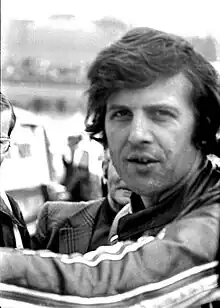
The series was sponsored by John Player and the name changed to Transatlantic Trophy. No longer a one-make series, the BSAs and Triumphs were joined by Nortons, Suzukis and a Harley Davidson.[10] The British won the series 252-210.[1] Cal Rayborn, on an obsolete Harley Davidson as the factory refused to let him use his works machine, and Ray Pickrell were the top scorers with 3 wins each.[1][20][21][22] Don Emde crashed heavily during practice at Oulton Park. His bike ended up in the lake and was hosed down by the Fire Brigade to remove the mud.[23]
| UK | USA | ||
|---|---|---|---|
| Rider | Machine | Rider | Machine |
| Phil Read (captain) | Norton | Dick Mann (captain) | BSA |
| John Cooper | BSA | Cal Rayborn | Harley Davidson |
| Tony Jefferies | Triumph | Don Emde | Norton |
| Ray Pickrell | BSA | Ron Grant | Suzuki |
| Peter Williams | Norton | Art Baumann | Suzuki |
| Tony Rutter | Norton | Jody Nicholas | Suzuki |
| References[3][10]: 17 | |||
1973

BSA-Triumph was now part of Norton Villiers Triumph[24] and the BSA brand had been dropped so only Triumph badged triples were entered.[25] Kawasaki bikes appeared for the first time, making 5 different marques on the grid. Britain won the series 416-398. Yvon Duhamel and Peter Williams were the top scorers in the wet races.[1]
| UK | USA | ||
|---|---|---|---|
| Rider | Machine | Rider | Machine |
| Paul Smart (captain) | Suzuki | Cal Rayborn (captain) | Harley Davidson |
| Barry Sheene | Suzuki | Mert Lawwill | Harley Davidson |
| John Cooper/Dave Croxford[lower-alpha 1] | John Player Norton | Doug Sehl | Harley Davidson |
| Peter Williams | John Player Norton | Gary Nixon | Kawasaki |
| Tony Jefferies | Triumph | Yvon Duhamel | Kawasaki |
| Percy Tait | Triumph | Art Baumann | Kawasaki |
| Mick Grant | Seeley-Kawasaki | Ron Grant | Suzuki |
| Dave Potter | Khun-Norton | Dave Aldana | John Player Norton |
| References[3][28] | |||
- Cooper crashed his 350 Yamsel in a support race at Mallory Park and Croxford took his place in the Mallory Trophy races.[26][27]
1974
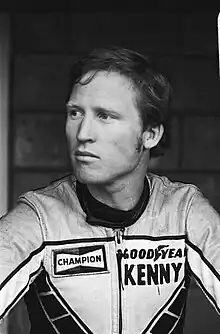
Yamaha motorcycles entered the series for the first time this year with the Yamaha TZ750.[29] Britain won the series 416-401 although American Kenny Roberts was the top scorer with 4 wins.[1] Roberts bike, which was fitted with the newly introduced slick tyres, nearly failed scrutineering for "bald tyres".[29]
| UK | USA | ||
|---|---|---|---|
| Rider | Machine | Rider | Machine |
| Paul Smart (captain) | Suzuki | Yvon Duhamel | Kawasaki |
| Peter Williams | John Player Norton | Kenny Roberts | Yamaha |
| Dave Croxford | John Player Norton | Gary Fisher | Yamaha |
| Barry Sheene | Suzuki | Gene Romero | Yamaha |
| Stan Woods | Suzuki | John Long | Yamaha |
| Barry Ditchburn | Yamaha | Dave Aldana | Norton |
| Mick Grant | Yamaha | Art Baumann | Kawasaki/Yamaha[lower-alpha 1] |
| Percy Tait | Triumph/Norton[lower-alpha 2] | Gary Nixon | Suzuki |
| Ron Chandler (reserve) | Kawasaki | Jim Evans (reserve) | Yamaha |
| References[3][14][30] | |||
1975
The Brands Hatch races were cancelled due to snow.[1] The first race at Mallory Park started dry but snow started to fall near the end of the race. The second race was wet and shortened from 20 to 15 laps.[29] Dave Aldana was the top scorer, although Kenny Roberts had won 3 races.[31] The American team had their first series win scoring 279-242.[1][32][33]
| UK | USA | ||
|---|---|---|---|
| Rider | Machine | Rider | Machine |
| Percy Tait (captain) | Yamaha | Kenny Roberts (captain) | Yamaha |
| Stan Woods | Suzuki | Gene Romero | Yamaha |
| John Newbold | Suzuki | Don Castro | Yamaha |
| Mick Grant | Kawasaki | Steve Baker | Yamaha |
| Barry Ditchburn | Kawasaki | Steve McLaughlin | Yamaha |
| Dave Croxford | Norton | Pat Hennen | Suzuki |
| Dave Potter | Yamaha | Dave Aldana | Suzuki |
| Pat Mahoney | Yamaha | Phil McDonald | Yamaha |
| Charlie Williams (reserve) | Yamaha | Randy Cleek (reserve) | Yamaha |
| References[3][34] | |||
1976
.jpg.webp)
The British team had included John Newbold, but he dropped out. Reserve Steve Parrish was promoted to a full team member and Ron Haslam brought in as the reserve.[3][35] Phil McDonald was to have been in the American team but was injured prior to the matches.[36]
Norton had commissioned Cosworth to build a twin-cylinder engine based on their highly successful DFV Formula 1 engine. Dave Croxford entered the series on one of the Cosworth-Nortons but the underdeveloped machine performed poorly at Brands and was withdrawn for the other two rounds.[37]
Steve Baker was the top scorer with 4 wins.[1]
| UK | USA | ||
|---|---|---|---|
| Rider | Machine | Rider | Machine |
| Phil Read (captain) | Yamaha | Kenny Roberts (captain) | Yamaha |
| Mick Grant | Kawasaki | Gene Romero | Yamaha |
| Barry Ditchburn | Kawasaki | Gary Nixon | Kawasaki |
| Dave Potter | Yamaha | Randy Cleek | Yamaha |
| Barry Sheene | Suzuki | Steve Baker | Yamaha |
| Steve Parrish | Suzuki | Pat Hennen | Suzuki |
| Dave Croxford | Cosworth-Norton | Pat Evans | Yamaha |
| John Williams | Suzuki | Ron Pierce | Kawasaki |
| Ron Haslam (reserve) | Yamaha | Marty Lunde (reserve) | Yamaha |
| References[3][35] | |||
1977
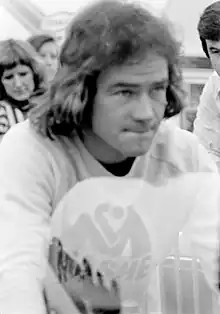
The American team was to consist of Dave Aldana, Steve Baker, Randy Cleek, Pat Evans, Pat Hennen, Ron Pierce, Kenny Roberts, Gary Scott and Dave Emde as reserve. Following a disagreement with his sponsor Pierce withdrew from the team. Emde was promoted to a full team member and Skip Aksland brought in as reserve. Evans was killed at the Imola Circuit the weekend prior to the Transatlantic Trophy and Cleek killed in a road accident on his way back from the Imola track. Pierce re-joined the team, Aksland was promoted to a full team member and Kevin Stafford introduced as reserve.[3][38][39]
Barry Sheene won one race for the UK but the other five races were won by Americans; Roberts won four races and Hennen one.[40] Hennen was the top scorer.[1] The Americans won the series 405-380.[41]
| UK | USA | ||
|---|---|---|---|
| Rider | Machine | Rider | Machine |
| Percy Tait (captain) | non-riding | Kenny Roberts (captain) | Yamaha |
| Steve Parrish | Suzuki | Pat Hennen | Suzuki |
| Phil Read | Kawasaki | Gary Scott | Yamaha |
| Dave Potter | Yamaha | Dave Emde | Yamaha |
| Barry Sheene | Suzuki | Dave Aldana | Yamaha |
| Paul Smart | Yamaha | Ron Pierce | Yamaha |
| John Williams | Yamaha | Skip Aksland | Yamaha |
| Mick Grant | Kawasaki | Steve Baker | Yamaha |
| Barry Ditchburn | Kawasaki | Kevin Stafford (reserve) | Yamaha |
| Roger Marshall (reserve) | Yamaha | ||
| References[3][42] | |||
1978

Barry Sheene, Mick Grant and Dave Potter were seeded into the team. The rest of the teams was decided by lap times during a qualifying session prior to the first race at Brands Hatch.[43]
The UK won the series 435-379 in front of a combined crowd of 150,000.[44] Pat Hennen was the top scorer.[1]
| UK | USA | ||
|---|---|---|---|
| Rider | Machine | Rider | Machine |
| Barry Sheene (captain) | Suzuki | Kenny Roberts (captain) | Yamaha |
| Mick Grant | Kawasaki | Pat Hennen | Suzuki |
| Dave Potter | Yamaha | Gene Romero | Yamaha |
| Barry Ditchburn | Yamaha | Dave Aldana | Yamaha |
| Roger Marshall | Yamaha | Skip Aksland | Yamaha |
| Ron Haslam | Yamaha | David Emde | Yamaha |
| John Williams | Yamaha | Dale Singleton | Yamaha |
| Steve Manship | Yamaha | Mike Baldwin | Yamaha |
| Steve Wright (reserve) | Yamaha | Bruce Hammer (reserve) | Yamaha |
| References[3][44] | |||
1979
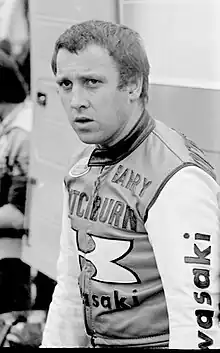
Barry Sheene, Mick Grant, Dave Potter, Barry Ditchburn, Tom Herron and Steve Parrish were seeded into the British team. The remaining three members qualified for their places in a qualifying session on the day before the first race at the Brands Hatch round.[12]
The American obtained the highest winning margin to date, 448-352, winning all 3 rounds. Mike Baldwin was the top scorer.[1]
| UK | USA | ||
|---|---|---|---|
| Rider | Machine | Rider | Machine |
| Barry Sheene (captain) | Suzuki | Dave Aldana (captain) | Yamaha |
| Mick Grant | Yamaha | Steve Baker | Yamaha |
| Dave Potter | Yamaha | Mike Baldwin | Yamaha |
| Barry Ditchburn | Kawasaki | Dale Singleton | Yamaha |
| Tom Herron | Suzuki | Gene Romero | Yamaha |
| Steve Parrish | Suzuki | Randy Mamola | Yamaha |
| John Newbold | Yamaha | Rich Schlachter | Yamaha |
| Ron Haslam | Yamaha | Wes Cooley | Yamaha |
| Keith Huewen | Yamaha | John Long | Yamaha |
| References[3][45] | |||
1980
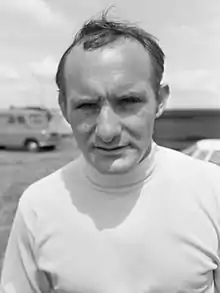
AMA Superbike Championship specification machines were permitted, allowing Dave Aldana and Wes Cooley to use 1,024cc Yoshimura Suzuki machines.[1][46] Americans won all the races: Kenny Roberts 3, Freddie Spencer 2 and Randy Mamola 1.[3] The USA won the series 442-370 and Roberts was the top scorer.[2] 140,000 fans attended the races.[47]
| UK | USA | ||
|---|---|---|---|
| Rider | Machine | Rider | Machine |
| Mike Hailwood (captain) | Non-riding | Kenny Roberts (captain) | Yamaha 750 |
| Barry Sheene | Yamaha 750 | Dale Singleton | Yamaha 750 |
| Ron Haslam | Yamaha 750 | Rich Schlachter | Yamaha 750 |
| Graeme Crosby | Suzuki 653, 500 | Freddie Spencer | Yamaha 750 |
| Keith Huewen | Yamaha 750 | John Long | Yamaha 750 |
| John Newbold | Yamaha 750 | Wes Cooley | Yoshimura-Suzuki 1024 |
| Graham Wood | Suzuki 500 | Randy Mamola | Suzuki 653, 500 |
| Dave Potter | Yamaha 750 | Dave Aldana | Yoshimura-Suzuki 1024 |
| Mick Grant | Yamaha 750 | Skip Aksland | Yamaha 750 |
| Steve Manship | Yamaha 750 | ||
| Alan Pacey (reserve) | Yamaha 750 | ||
| References[2][3][46] | |||
1981

The American team was depleted for the 1981 races. World Champion Kenny Roberts was unavailable for the series as he was required by Yamaha to test their new square four GP racer.[48] Dave Aldana and Mike Baldwin were competing in the 24 Hours of Le Mans endurance race for Honda.[13] Yoshimura and Suzuki refused to allow Wes Cooley to use his Superbike for the series and he used a borrowed a 750 Yamaha for the races. A Honda America Superbike wasn't available for Freddie Spencer to use and had to compete on a borrowed Suzuki RG500.[48]
Randy Mamola won three races for the US.[3] John Newbold was the top points scorer for Great Britain, who won the series 466-345..[49]
| UK | USA | ||
|---|---|---|---|
| Rider | Machine | Rider | Machine |
| Joey Dunlop | Honda 1100 | James Adamo | Yamaha 750 |
| Ron Haslam | Honda 1100 | Dan Chivington | Yamaha 750 |
| Steve Henshaw | Yamaha 750 | Wes Cooley | Yamaha 750 |
| Keith Huewen | Suzuki 500 | John Long | Yamaha 750 |
| Roger Marshall | Kawasaki 1000 | Randy Mamola | Suzuki 500 |
| John Newbold | Suzuki 1000 | Nicky Richichi | Yamaha 750 |
| Dave Potter | Yamaha 750 | Rich Schlachter | Yamaha 750 |
| Barry Sheene | Yamaha 750 | Dale Singleton | Yamaha 750 |
| Graham Wood | Yamaha 750 | Freddie Spencer | Suzuki 500 |
| References[3] | |||
1982
The American team was again understrength this year with Kenny Roberts and Randy Mamola testing GP machines. Freddie Spencer crashed in the first race and destroyed his machine. Without a spare available he was out for the rest of the match. Barry Sheene won 5 of the 6 races. A mistake on the last lap of the other race while in the lead allowed Roger Marshall to pass and deprive Sheene of a $40,0000 bonus for winning all the races.[13]
Sheene was the top scorer with Dave Aldana the top scoring American. Britain won the series 491-313.[13]
| UK | USA | ||
|---|---|---|---|
| Rider | Machine | Rider | Machine |
| Steve Henshaw | 750 Yamaha | Dave Aldana | 750 Yamaha |
| Keith Huewen | 500 Suzuki | Mike Baldwin | 1000 Honda |
| Gary Lingham | 500 Suzuki | Wes Cooley | 997 Suzuki |
| Roger Marshall | 997 Suzuki | Mark Homchick | 750 Yamaha |
| John Newbold | 997 Suzuki | Roberto Pietri | Suzuki |
| Steve Parrish | 500 Yamaha | Nicky Richichi | 750 Yamaha |
| Barry Sheene | 500 Yamaha | Rich Schlachter | 750 Yamaha |
| Bob Smith | 500 Suzuki | Dale Singleton | 750 Yamaha |
| Graham Wood | 750 Yamaha | Alan Ward | 750 Yamaha |
| References[3] | |||
1983
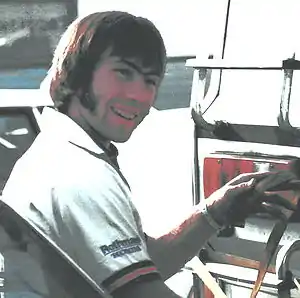
Motor Circuit Developments (MCD), the owners of the 3 circuits used for the races, Brands Hatch, Mallory Park and Oulton Park, came under financial pressure from their parent company, Eagle Star Insurance in 1982. This resulted in MCD selling Mallory Park in late 1982. Snetterton was owned by MCD and was chosen to replace Mallory Park. To fit into Snetterton's schedule, the Trophy races were pushed back from Easter to May Day weekend and the order of races reversed. Oulton Park held the first races and Brands Hatch the last.[13]
The later running of the races meant the GP season had started and Honda would not sanction Freddie Spencer taking part. Mike Baldwin fell in the first race and broke three toes, putting him out of the rest of the races. As there were no reserve riders, the American team raced with a man short. Kenny Roberts and Eddie Lawson were both on the Yamaha square 4 680 cc OW69 that they had scored a 1-2 at that year's Daytona 200. But the wet conditions and tight circuits didn't allow them to make full use of the considerable power the Yamaha made.[13]
Ron Haslam was the top scorer and won four races, Randy Mamola won the other two. Britain won the series 245-198.[3][50]
| UK | USA | ||
|---|---|---|---|
| Rider | Machine | Rider | Machine |
| Ron Haslam | 500 Honda | Dave Aldana | 500 Suzuki |
| Keith Huewen | 500 Suzuki | Mike Baldwin | 999 Honda |
| Roger Marshall | 500 Honda | Wes Cooley | 1025 Kawasaki |
| Mark Salle | 500 Suzuki | Eddie Lawson | 680 Yamaha |
| Barry Sheene | 500 Suzuki | Randy Mamola | 500 Suzuki |
| Graham Wood | 750 Yamaha | Kenny Roberts | 680 Yamaha |
| References[3] | |||
1984
.jpg.webp)
There were allegations of financial irregularities by Motor Circuit Developments, owners of the circuits the matches were run on, in late 1983 and the future of the matches was in doubt. Tom Wheatcroft, owner of Donington Park, stepped in and arranged for the series to be staged at Donington. The races were run at Donington with 3 races each day on Easter Sunday and Monday in front of an 85,000 crowd.[14]
The British team included New Zealander Graeme Crosby and Australian Wayne Gardner[3] was billed as the British Commonwealth.[15]
The American team included the top four of the 1983 GP Championship. Wayne Rainey was injured in a crash in practice and didn't compete in the races.[17] Freddie Spencer crashed in the races and broke bones in both his feet.[14]
Americans won all the races; Randy Mamola winning three, Spencer two and Kenny Roberts one, and won the series 259-136.[3]
| British Commonwealth | USA | ||
|---|---|---|---|
| Rider | Machine | Rider | Machine |
| Ron Haslam | Honda NS500 | Freddie Spencer | Suzuki RG500 |
| Barry Sheene | Suzuki RG500 | Kenny Roberts | Yamaha TZR500 |
| Wayne Gardner | Honda RS500 | Randy Mamola | Honda NS500 |
| Roger Marshall | Honda RS500 | Eddie Lawson | Yamaha TZR500 |
| Graeme Crosby | Yoshimura-Suzuki 1023 | Wayne Rainey | Yamaha TZ500 |
| Keith Huewen | Honda RS500 | Wes Cooley | Honda RS500 |
| Rob McElnea | Suzuki RG500 | Mike Baldwin | Honda RS500 |
| References[3][15] | |||
1985
The match returned to its usual format of two races a day on Good Friday, Easter Sunday and Easter Monday which was less demanding for the riders. Honda refused to let Freddie Spencer take part and Yamaha blocked Eddie Lawson's participation. Kenny Roberts was busy putting together a 500 cc GP team, leaving Randy Mamola and Mike Baldwin to lead a team of mostly non-factory riders.[13]
Wayne Gardner, the Australian riding for Britain, won three races and Mamola two. Britain won the series 336-254.[3]
| UK | USA | ||
|---|---|---|---|
| Rider | Machine | Rider | Machine |
| Ron Haslam | 500 Honda | Mike Baldwin | 500 Honda |
| Steve Parrish | 500 Yamaha | Rich Schlachter | 500 Honda |
| Wayne Gardner | 500 Honda | Randy Mamola | 500 Honda |
| Roger Burnett | 500 Honda | James Adamo | 500 Cagiva |
| Mick Grant | 998 Suzuki | Doug Brauneck | Yamaha |
| Roger Marshall | 500 Honda | Randy Renfrow | 500 Honda |
| Gary Lingham | 500 Suzuki | Jeff Haney | 500 Honda |
| Rob McElnea | 500 Suzuki | Wayne Rainey | Honda |
| References[3][16] | |||
1986

With the lack of American riders competing in GP racing and the rise in popularity of Superbikes both sides of the Atlantic, the series was run for Superbikes only. With the top US riders tied to GP contracts, the American team consisted of riders not well known outside the US.[13]
As he was unable to use his GP bike, Honda gave Ron Haslam a tuned version of the VFR750 to use. The bike blew up in practice leaving Haslam without a machine for the races. Haslam brought a new road-going version of the VFR750 from a local dealer, stripped off as many road going parts and fitted racing tyres. The tyres were intended for a 250 but were the largest that would fit on the bike. It rained during the first race making the lack of power and ground clearance compared to the full-blown superbikes less of a problem. Haslam finished in third place.[51]
8 races were run over the Easter weekend. Kevin Schwantz won 4 and Fred Merkel two.[13] Britain beat the USA 314-214. Kevin Schwantz was the top scorer with 84 points.[52]
| UK | USA | ||
|---|---|---|---|
| Rider | Machine | Rider | Machine |
| Rob McElnea (captain) | Yamaha 750 | Fred Merkel (captain) | Honda 750 |
| Ron Haslam | Honda 750 | Ricky Orlando | Honda |
| Steve Parrish | Yamaha 750 | Glenn Barry | Honda |
| Neil Robinson | Suzuki | Rueben McMurter | Yamaha 750 |
| Kenny Irons | Yamaha 750 | Sam McDonald | Yamaha |
| Roger Burnett | Honda 750 | Dale Quarterley | Yamaha 750 |
| Roger Marshall | Honda 750 | Kevin Schwantz | Suzuki 750 |
| Gary Lingham | Suzuki | John Ashmead | Honda |
| Keith Huewen | Suzuki 750 | John Bettencourt | Honda 750 |
| Graeme McGregor | Suzuki | Dan Chivington | Yamaha 750 |
| Trevor Nation | Suzuki 750 | Michel Mercier | Suzuki 750 |
| Chris Martin | Suzuki 750 | Lance Jones | Honda |
| Paul Iddon | Suzuki 750 | Ted Boody | Yamaha |
| References[3][53] | |||
1987
Brands Hatch returned as a venue, with 3 races on Good Friday. Donington hosted six races on Easter Sunday and Monday.[3] A 12 man British team were matched against an 11 man American team. Only the top ten riders of each team were awarded points in races. The motorcycles were to American Superbike specification.[17] 1987 American captain Fred Merkel couldn't agree terms for 1988 so wasn't in the team.[54] Three Canadians joined the American team: Michel Mercier and Gary Goodfellow with the backing of Suzuki Canada and Reuben McMurter from Yamaha Canada.[17] American Bubba Shobert crashed in practice and was unable to compete in the races.[54]
The intense rivalry between Kevin Schwantz and Wayne Rainey carried over into the match races giving the British audience a preview of future battling between the pair in GP racing.[55][56]
All the races were won by Americans, Wayne Rainey won 5 of the races and Kevin Schwantz 4. America won the series 993.5-745.5.[3]
| UK | USA | ||
|---|---|---|---|
| Rider | Machine | Rider | Machine |
| Simon Buckmaster | 750 Honda | Wayne Rainey | 750 Honda |
| Mark Phillips | 750 Suzuki | Gary Goodfellow | 750 Suzuki |
| Ray Swann | 750 Suzuki | Ottis Lance | 750 Suzuki |
| Trevor Nation | 750 Yamaha | Jim Filice | 750 Yamaha |
| Ron Haslam | 750 Honda | Doug Polen | 750 Suzuki |
| Phil Mellor | 750 Suzuki | Reuben McMurter | 750 Yamaha |
| Jamie Whitham | 750 Suzuki | Kevin Schwantz | 750 Suzuki |
| Keith Huewen | 750 Yamaha | Michel Mercier | 750 Suzuki |
| Geoff Fowler | 750 Yamaha | John Ashmead | 750 Honda |
| Roger Hurst | 750 Yamaha | Dan Chivington | 750 Honda |
| Peter Dalby | 750 Suzuki | Bubba Shobert | 750 Honda |
| Gary Lingham | Kawasaki | ||
| References[3][17] | |||
1988
Donington was to host the inaugural round of the Superbike World Championship on Easter Sunday. For the mutual benefit of both WSB and the Transatlantic Match (which both used similar specification machines) the Transatlanic series was expanded to four teams and renamed the Eurolantic Challenge as it included European riders. For the promotors this allowed them to spread the costs over two series, and for the riders this offered the prospect of extra payday.[18]
The British No 1 team were led by Ron Haslam and the riders were all factory backed.[54] The American team was led by Bubba Shobert on a works Honda VFR750. For the first time, Yoshimura Suzuki sent a factory crew to support Doug Polen and Scott Gray. Four Canadians joined the American team on works bikes.[18]
Norton had introduced a twin rotor Wankel engined racer, the RC588. Although nominally 588 cc, the FIM had yet to agree with Norton the method of measuring displacement of the rotary engine. Until this was resolved the Norton could only race in national and non-championship races. Two machines were entered into the Eurolantic Challenge, ridden by Trevor Nation and Simon Buckmaster. This would be the first time the machines were raced.[54]
There were 3 races at Brands Hatch on Good Friday and 3 races at Donington on Easter Monday (the WSB races being on Easter Sunday).[54] Polen was the top scorer and had won four races. Shobert had won the other two. The British No 1 team were overall winners with 586 points, the Americans second with 570 points. Most of the European team left after the WSB and didn't compete on the Monday. This was reflected in their score of 287 points. The British No 2 team scored 281 points.[4]
| UK 1 | USA | UK 2 | Europe | ||||
|---|---|---|---|---|---|---|---|
| Rider | Machine | Rider | Machine | Rider | Machine | Rider | Machine |
| Ron Haslam (captain) | Elf Honda | Bubba Shobert (captain) | Honda | Roger Marshall (captain) | Padgett Suzuki | Anders Anderson | Suzuki |
| Joey Dunlop | Gemini Honda RC30 | Fred Merkel | Honda | Trevor Nation | Norton | Peter Rubatto | Bimota Yamaha |
| Mark Phillips | Bimota Yamaha | Doug Polen | Yoshimura Suzuki | Kenny Irons | Bridge Honda RC30 | Jari Suhonen | Yamaha |
| Roger Burnett | Shell Honda | Gary Goodfellow | Suzuki | Simon Buckmaster | Norton | Esko Kuparinen | Kawasaki |
| Phil Mellor | Suzuki | Rueben McMurter | Yamaha | Andy McGladdery | Suzuki | Paul Ramon | Honda RC30 |
| Keith Huewen | Bimota Yamaha | Michel Mercier | Suzuki | Paul Iddon | Bimota Suzuki | Hans Lindner | Honda |
| Jamie Whitham | Suzuki | Tom Douglas | Yamaha | David Heal | Suzuki | Graeme McGregor | Honda RC30 |
| Ray Swann | Kawasaki | Scott Gray | Suzuki | Darren Dixon | Padgett Suzuki | Michael Galinski | Bimota Yamaha |
| Terry Rymer (reserve) | Yamaha | Dieter Heinen | Honda RC30 | ||||
| Mark Linscott (reserve) | Suzuki | ||||||
| References[54] | |||||||
1991
The series consisted of three races at Mallory Park and three at Brands Hatch,[14] the series was called the Transatlantic Superbike Challenge and run in early May.[3] The British team, led by captain Ron Haslam, was well known to racing fans but apart from captain Freddie Spencer, the American team were relatively unknown.[6] Canadian Miguel Duhamel, son of Yvon Duhamel, who had competed in the 1973 and 1974 matches, was in the American team.[57]
Ray Stringer won all three races at Brands Hatch. Haslam won two and Rob McElnea one at Mallory.[3] Britain won the series 625-161 and Stringer was the top scorer.[5]
| UK | USA | ||
|---|---|---|---|
| Rider | Machine | Rider | Machine |
| Ron Haslam (captain) | JPS Norton RCW588 | Freddie Spencer (captain) | Honda VFR 750 |
| Terry Rymer | Yamaha FZR 750R | Thomas Stevens | Yamaha FZR 750R |
| Brian Morrison | Yamaha FZR 750R | Jamie James | Yamaha FZR 750R |
| Trevor Nation | JPS Norton RCW588 | Scott Russell | Kawasaki ZXR 750R |
| Steve Spray | Kawasaki ZXR 750R | Jaques Guenette | Kawasaki ZXR 750R |
| Jamie Whitham | Suzuki GSXR 750R | Richard Arnaiz | Honda VFR 750 |
| John Reynolds | Kawasaki ZXR 750R | Robert Holden | Honda VFR 750 |
| Rob McElnea | Yamaha FZR 750R | Luis Carlos Maurel | Yamaha FZR 750R |
| Carl Fogarty | Honda VFR 750 | Marcello Del Guidice | |
| Ray Stringer | Yamaha FZR 750R | John Long | Suzuki GSXR 750R |
| Niall MacKenzie | Honda VFR 750 | Michael Barnes | Yamaha FZR 750R |
| Mark Linscott | Honda VFR 750 | Miguel Duhamel | Honda VFR 750 |
| References[14][57] | |||
Revivals
Triumph Motorcycles Ltd revived the concept in 1996 with a single-make 3 race match at Donington using the 900 cc Speed Triple. Amongst the Americans competing was Dave Aldana, who had competed in the first Anglo-American Match Races in 1971. Britain won overall 614-426.[3][58]
The concept was again revived in May 2015 as part of the MCN Festival of Motorcycling at the East of England Showground when a Transatlantic Trophy was staged between British and American teams flat track racing.[59] The event was repeated at the 2016 show.[60][61]
In late 2015, MotoAmerica and BSB officials looked into the possibility of reviving the Transatlantic Trophy races, with races at three different circuits over a long weekend.[62]
References
- "Teamwork's The Key" (PDF). Motor Cycle News. 2 April 1980. p. 36. Retrieved 27 March 2021.
- "Roberts Leads U.S. Win". Daytona Beach Morning Journal. Associated Press. 7 April 1980. p. 4. Retrieved 28 March 2021.
- "The Transatlantic Trophy (Anglo-American Match)". Racing Memo (in French). Retrieved 1 April 2021.
- Fraser, Colin (12 April 2012). "Remembering the First World Superbike Race – Part Three"". fraser96.rssing.com. Retrieved 2 April 2021.
- 1991 US vs UK Mallory & Brands. 8 November 2013. Retrieved 2 April 2021 – via YouTube.
- Cardoso, Luís (3 August 2019). "Transatlantic Trophy". motospotnews (in Portuguese). Retrieved 3 April 2021.
- Cox, Bruce (18 October 2016). "The Anglo-american match races". Classic Racer. Retrieved 28 March 2021 – via www.pressreader.com.
- Miller, Robin (26 November 2019). "Brands Hatch supremo Chris Lowe has died". BikeSport. Retrieved 28 March 2021.
- "Brands Hatch Programme" (PDF). 9 April 1971. Retrieved 30 March 2021 – via daveriley.weebly.com.
- "Brands Hatch Programme" (PDF). 31 March 1972. Retrieved 30 March 2021 – via daveriley.weebly.com.
- "750s: Racing goes technicolour". www.motorcyclenews.com. 10 April 2016. Retrieved 29 March 2021.
- "Brands Hatch Programme" (PDF). 13 April 1979. Retrieved 1 April 2021 – via daveriley.weebly.com.
- "Match Races: Part 4". Classic Racer. 18 April 2017. Retrieved 2 April 2021 – via PressReader.
- Barker, Stuart (31 May 2016). "Whatever happened to Transatlantic racing?". www.motorcyclenews.com. Retrieved 29 March 2021.
- "Donington Programme" (PDF). 21 April 1984. Retrieved 1 April 2021 – via daveriley.weebly.com.
- "Donington Programme" (PDF). 6 April 1985. Retrieved 1 April 2021 – via daveriley.weebly.com.
- "Brands Hatch Programme" (PDF). 17 April 1987. Retrieved 2 April 2021 – via daveriley.weebly.com.
- Fraser, Colin (17 March 2012). "Colin's Corner: Remembering the first ever World Superbike Race"". rssing.com. Retrieved 3 April 2021.
- "Great News – Stafford Motorcycle Mechanics Show, Oct'16 – John's Motorcycle News". www.johnsmotorcyclenews.co.uk. Retrieved 30 March 2021.
- "Ray Pickrell". Daily Telegraph. 1 May 2006. Archived from the original on 11 September 2012.
- "Remembering Cal Rayborn". superbikeplanet.com. Archived from the original on 27 September 2011. Retrieved 28 March 2021.
- Assoc, American Motorcyclist (June 1972). '72 Match Races - A Pause For Thought. pp. 22–24. Retrieved 7 August 2011.
{{cite book}}:|work=ignored (help) - "1972 Gus Kuhn Racing". www.guskuhn.net. Retrieved 28 March 2021.
- "Norton Villiers motorcycles". www.historywebsite.co.uk. Retrieved 31 March 2021.
- "The Trident three-cylinder in the US". www.triplesonline.com. Retrieved 31 March 2021.
- Crawford, Pete (18 August 2020). "Dave Croxford". Classic Racer. Retrieved 22 May 2021 – via PressReader.com.
- Swift, Jim (1976). Ride it! : the complete book of big bike racing. Yeovil: Foulis. p. 64. ISBN 978-0-85429-220-2.
- "Brands Hatch Programme" (PDF). 20 April 1973. Retrieved 31 March 2021 – via daveriley.weebly.com.
- "The Match Races - Part 3". Classic Racer. 14 February 2017. Retrieved 31 March 2021 – via www.pressreader.com.
- "Brands Hatch Programme" (PDF). 12 April 1974. Retrieved 31 March 2021 – via daveriley.weebly.com.
- Assoc, American Motorcyclist (January 1976). World Title Challengers. Retrieved 28 March 2021.
{{cite book}}:|work=ignored (help) - Classic Racer, September/October 2008, Issue 133, p. 36, William Gibbons & Son, Wolverhampton. ISSN 1470-4463
- B.R., Nicholls (August 1975). "Tansatlantic Trophy, Part V". Cycle World Magazine. pp. 50–51, 96–98. Retrieved 2 April 2021.
- "Mallory Park Programme" (PDF). 30 March 1975. Retrieved 31 March 2021 – via daveriley.weebly.com.
- "Mallory Park Programme" (PDF). 18 April 1976. Retrieved 31 March 2021 – via daveriley.weebly.com.
- "John Player Transatlantic Trophy". Cycle World Magazine. August 1976. pp. 86–87. Retrieved 2 April 2021.
- "Bonhams : 1975 Norton Challenge P86 Frame no. 003". www.bonhams.com. Retrieved 3 April 2021.
- "Brands Hatch Programme" (PDF). 8 April 1977. Retrieved 1 April 2021 – via daveriley.weebly.com.
- "Not forgotten - Randy Cleek and Pat Evans". Australian Motorcycle News. 13 May 2017. Retrieved 1 April 2021.
- Whyte, Norrie (January 1978). Turning The Tables. Retrieved 28 March 2021.
{{cite book}}:|work=ignored (help) - "Turning The Tables". American Motorcyclist. American Motorcyclist Assoc. January 1978. pp. 42–44. Retrieved 2 April 2021.
- Assoc, American Motorcyclist (June 1977). Roberts, Hennen lead U.S. team past British in Match Races. p. 27. Retrieved 28 March 2021.
{{cite book}}:|work=ignored (help) - "Brands Hatch Programme" (PDF). 24 March 1978. Retrieved 1 April 2021 – via daveriley.weebly.com.
- Assoc, American Motorcyclist (June 1978). Match Races: Far from perfect, but still neat. p. 30. Retrieved 28 March 2021.
{{cite book}}:|work=ignored (help) - "Underdog Yanks Blitz British". American Motorcyclist. July 1979. pp. 34–35. Retrieved 28 March 2021.
- "Brands Hatch Programme (part 1)" (PDF). 4 April 1980. Retrieved 1 April 2021 – via daveriley.weebly.com.
- "Roberts, Spencer, Mamola Dominate Match Races". Cycle World Magazine. August 1980. pp. 82–84. Retrieved 2 April 2021.
- Harris, Nick (1981). "Team Victory for Britain". In Clifford, Peter (ed.). Motocourse 1981-82. Surrey, Eng.: Hazleton Pub. p. 153. ISBN 978-0905138183.
- Stead, Jean (21 April 1981). "Motor Cycling - Britain's Record Haul over America". The Guardian. London. p. 24.
- Lawrence, Larry (4 January 2018). "Throwback Thursday: Team USA Shivers at the 1983 Match Races". Cycle News. Retrieved 1 April 2021.
- Barker, Stuart (13 February 2016). "25 Years of the VFR: Part 1". www.motorcyclenews.com. Retrieved 3 April 2021.
- "Parade Lap". American Motorcyclist. American Motorcyclist Assoc. June 1986. p. 75. Retrieved 2 April 2021.
- "Donington Programme" (PDF). 30 March 1986. Retrieved 2 April 2021 – via daveriley.weebly.com.
- "Brands Hatch Programme" (PDF). 1 April 1988. Retrieved 2 April 2021 – via daveriley.weebly.com.
- "Kevin Schwantz at the Motorcycle Hall of Fame". motorcyclemuseum.org. Retrieved 3 April 2021.
- "Wayne Rainey at the Motorcycle Hall of Fame". motorcyclemuseum.org. Archived from the original on 3 March 2016. Retrieved 3 April 2021.
- "Brands Hatch Programme" (PDF). 6 May 1991. Retrieved 2 April 2021 – via daveriley.weebly.com.
- Edwards, David (August 1996). "Notes from Seat 21A". Cycle World Magazine. Retrieved 2 April 2021.
- "Historic race bikes line up for MCN Festival". Classic Motorbikes. 16 April 2015. Retrieved 29 March 2021.
- "The MCN festival of Motorcycling – Sidecarland". sidecarland.co.uk. Retrieved 29 March 2021.
- "British domination at DTRA". MC Federation. 20 May 2016. Retrieved 29 March 2021.
- "MotoAmerica, BSB Officials Considering Reviving Trans-Atlantic Match Races". Roadracing World Magazine | Motorcycle Riding, Racing & Tech News. 30 December 2015. Retrieved 2 April 2021.
External links
- "1980 Transatlantic Race Brands Hatch". British Pathé.